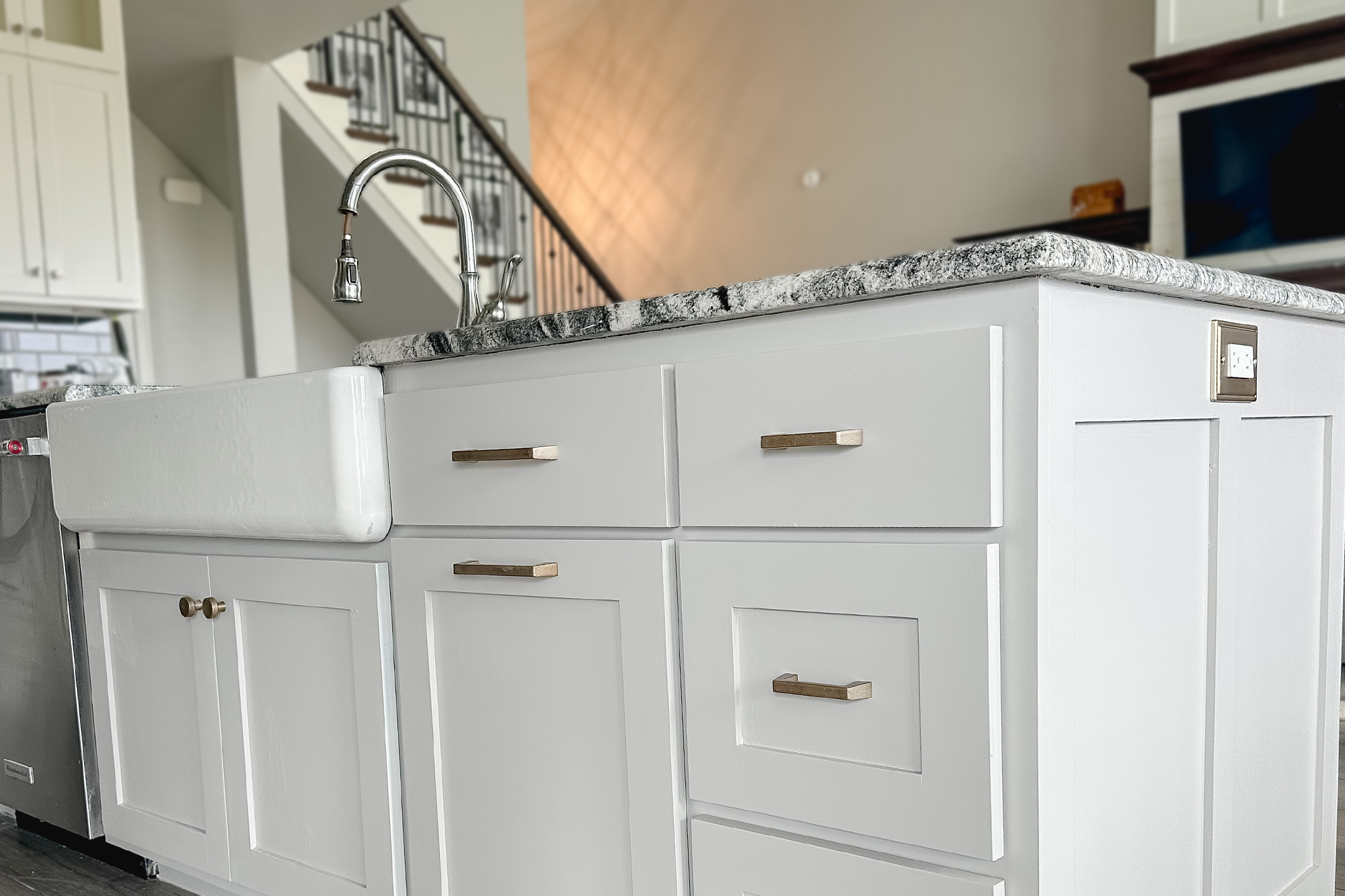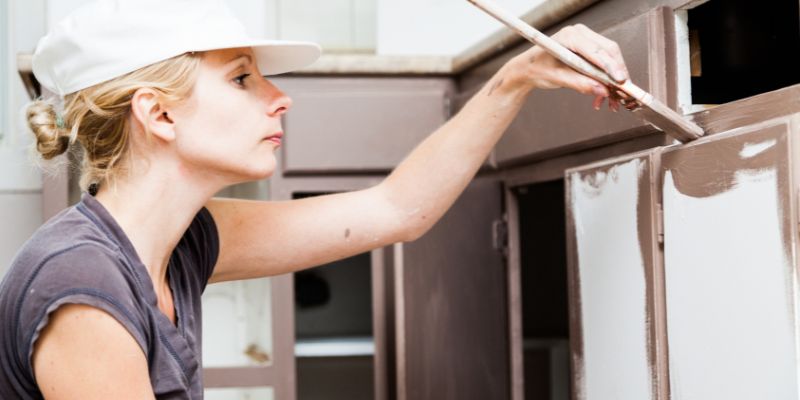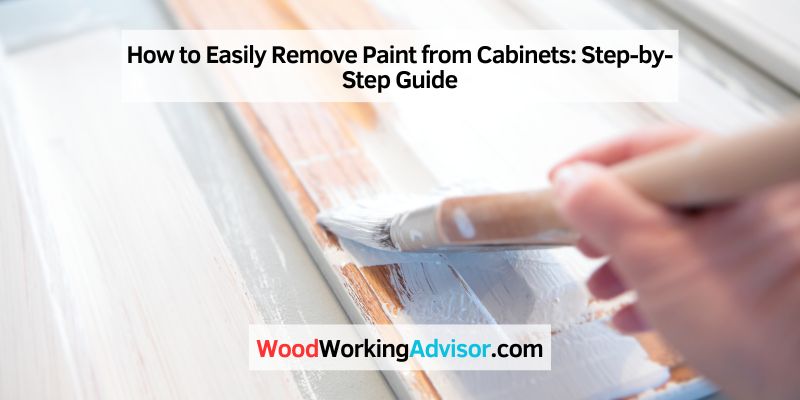To get paint off cabinets, use a scraper or sandpaper to gently remove the paint. Then, clean the surface with warm soapy water to ensure a smooth finish.
Paint stains on cabinets can be a frustrating sight. Whether it’s an accidental spill or an old paint job that needs updating, removing paint from cabinets requires careful attention and the right tools. In this guide, we will discuss simple steps to get rid of paint stains on cabinets.
By using a scraper or sandpaper, you can gently scrape off the paint without damaging the underlying wood or laminate. Once the paint is removed, clean the surface with warm soapy water to ensure a clean and smooth finish. Let’s dive into the details of how to effectively get paint off cabinets.

Credit: www.littledekonings.com
Preparation
Learn how to effectively remove paint from cabinets with these expert tips. Prepare the surface by sanding it lightly, applying a paint stripper, and using a scraper to carefully remove the paint. Make sure to protect the surrounding areas and wear appropriate safety gear throughout the process.
Gather Materials
To properly prepare for removing paint from cabinets, it’s essential to gather all the necessary materials beforehand. By having everything on hand, you’ll save time and ensure a smooth process. Here’s a list of items you’ll need:
- Rubber gloves
- Protective eyewear
- Dust mask
- Dropcloth or plastic sheeting
- Painter’s tape
- Putty knife or scraper
- Sandpaper (medium and fine grit)
- Paint stripper
- Clean rags or sponges
- Bucket with warm water
- Mild soap
Protect The Surrounding Area
Before you start the paint removal process, it’s crucial to protect the surrounding area to prevent any accidental damage. Here are a few steps to safeguard your cabinets and the surrounding space:
- Clear the area: Remove any items, such as dishes or utensils, from the cabinets to avoid potential damage or contamination.
- Cover countertops and floors: Place a dropcloth or plastic sheeting over the countertops and floors around the cabinets. This will catch any paint chips or drips and make for easier cleanup.
- Tape off adjacent surfaces: Apply painter’s tape to the edges of the cabinets, walls, or any other adjacent surfaces that you want to keep paint-free.
- Seal cabinet hardware: If you’re not removing the cabinet hardware, protect it by covering it with painter’s tape or plastic wrap. This will prevent any accidental paint splatters.
By carefully following these preparation steps, you’ll ensure a successful paint removal process without any unwanted damage or mess. Properly gathering all the materials and protecting the surrounding area will allow you to focus on effectively removing the paint from your cabinets.
Removing The Paint
When it comes to giving your kitchen cabinets a fresh look, removing the old paint is an essential step. Whether you want to refinish the cabinets or apply a new coat of paint, starting with a clean slate ensures a smooth and professional-looking finish. In this section, we will explore three effective methods for removing paint from cabinets: testing a small area first, using paint remover or stripper, and scraping off the paint. Let’s dive into each method and find the one that suits your needs best.
Test A Small Area First
Before you start removing the paint from your entire kitchen cabinet, it’s wise to test a small area first. This gives you the opportunity to determine the effectiveness of the method you choose and avoid any unpleasant surprises. Choose an inconspicuous spot, such as the inside of a cabinet door or the back of the cabinet, and apply the selected paint remover or stripper. Let it sit for the recommended amount of time, and then scrape it off gently. If the paint comes off easily without damaging the surface of the cabinet, you can proceed with confidence to the next step.
Use Paint Remover Or Stripper
If the test area yielded positive results, it’s time to move on to the next stage: using a paint remover or stripper. These products are specifically designed to soften and dissolve the paint, making it easier to remove. Before applying the remover, make sure you protect yourself by wearing gloves, safety goggles, and a mask to avoid inhaling any potentially harmful fumes. Apply the paint remover or stripper according to the manufacturer’s instructions, using a brush or a cloth to ensure thorough and even coverage. Let it sit for the recommended time, allowing it to work its magic on the old paint.
Scrape Off The Paint
Once the paint remover or stripper has had time to work, it’s time to scrape off the paint. Using a plastic or metal scraper, gently remove the softened paint from the surface of the cabinet. Be careful not to apply too much pressure, as this could damage the wood or other material in your cabinets. Work in small sections, moving systematically across the cabinet, until all the paint has been removed. If there are any stubborn areas, you can reapply the paint remover and allow it to sit for a bit longer before scraping.
Remember to keep a container nearby to collect the scraped-off paint and dispose of it safely. This will help to keep your workspace clean and tidy throughout the process. Once you have removed all the paint, you can move on to the final step: sanding the surface. Sanding helps to smooth out any remaining imperfections and prepares the cabinets for their new finish.
Cleaning Up
Following the process of removing paint from your cabinets, the next step is cleaning up to ensure the cabinets are returned to their pristine state. Proper cleaning is essential to remove any leftover residue and restore the cabinets to their original luster.
Remove Residue
After the paint removal process, there may be residual paint or cleaning solutions on the cabinets. Use a gentle solvent or degreaser and a soft cloth to carefully wipe away any remaining residue. Be cautious not to damage the cabinet finish while rubbing off the residue.
Clean And Dry The Cabinets
Once all the paint and residue are removed, it’s crucial to clean the cabinets thoroughly. Use a mild solution of soapy water and a soft sponge to wipe down all surfaces. Be sure to rinse the cabinets with clean water to remove any soap residue. Then, dry the cabinets completely with a clean, lint-free cloth to prevent water spots and streaks from forming.

Credit: www.kilz.com
Finishing Touches
Once you have successfully removed the paint from your cabinets, it’s time to add the finishing touches to bring them back to their former glory. The final steps will involve applying a new finish and reassembling the cabinets.
Apply A New Finish
Step 1: Before applying a new finish, make sure the cabinets are clean and free from any debris or dust. You can use a damp cloth to wipe them down, ensuring a smooth surface for painting.
Step 2: Choose a suitable paint or stain color that complements your kitchen decor. Consider the style and atmosphere you want to create in your kitchen. You can opt for a vibrant color to add a pop of personality or stick to a classic wood stain for a timeless look.
Step 3: Use a high-quality brush or a paint sprayer to apply the new finish. Make sure to follow the manufacturer’s instructions for the best results. Apply thin and even coats, allowing each coat to dry completely before applying the next.
Reassemble The Cabinets
Step 1: Once the new finish has dried, it’s time to reassemble the cabinets. Start by reattaching the doors using the screws or hinges that were previously removed. Ensure that each door is aligned correctly.
Step 2: If you removed the cabinet hardware, such as handles or knobs, clean them thoroughly before reinstalling. Make sure they are tightened securely to prevent any future issues.
Step 3: Finally, check all the drawers, hinges, and slides for smooth functioning. Adjust or lubricate them if necessary, ensuring that everything is in working order.

Frequently Asked Questions On How To Get Paint Off Cabinets
How Do You Get Dried Paint Off Wood Cabinets?
To remove dried paint from wood cabinets, gently scrape off the excess with a plastic scraper. Apply a mixture of warm water and mild soap to the stained area. Use a soft cloth to rub the paint off. For stubborn spots, use a commercial paint remover and follow the manufacturer’s instructions.
Can Paint Be Removed From Kitchen Cabinets?
Yes, paint can be removed from kitchen cabinets. You can use a paint stripper or sandpaper to remove the paint. Be sure to follow the instructions carefully and take necessary safety precautions.
Will Vinegar Remove Paint From Cabinets?
Yes, vinegar can remove paint from cabinets effectively. It is a natural and safe option for paint removal.
What Is The Best Paint Remover For Cabinets?
The best paint remover for cabinets is a gel-based, eco-friendly solution that effectively strips multiple layers without damaging the wood. Look for a product specifically designed for wood surfaces, ensuring it is safe and easy to apply. Always follow the manufacturer’s instructions for best results.
Conclusion
To wrap up, removing paint from cabinets may seem daunting, but with the right tools and methods, it’s entirely achievable. Whether you opt for natural remedies or store-bought products, the key is patience and persistence. By following the steps outlined in this guide, you can restore your cabinets to their original beauty without any hassle.



One thought on “How to Easily Remove Paint from Cabinets: Step-by-Step Guide”